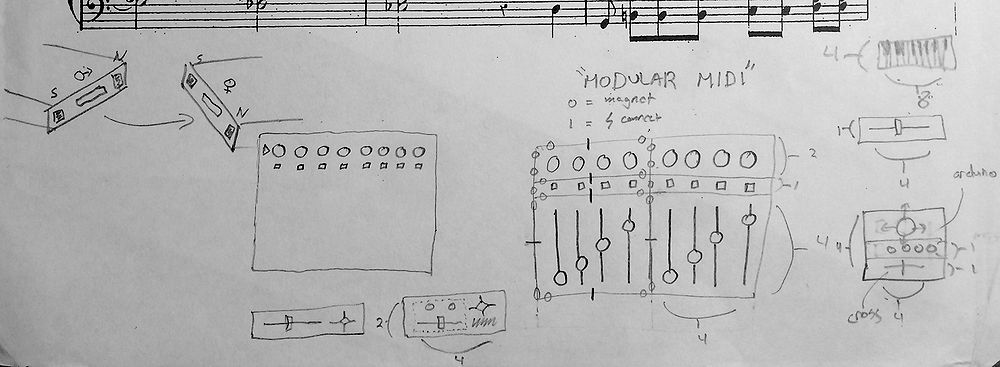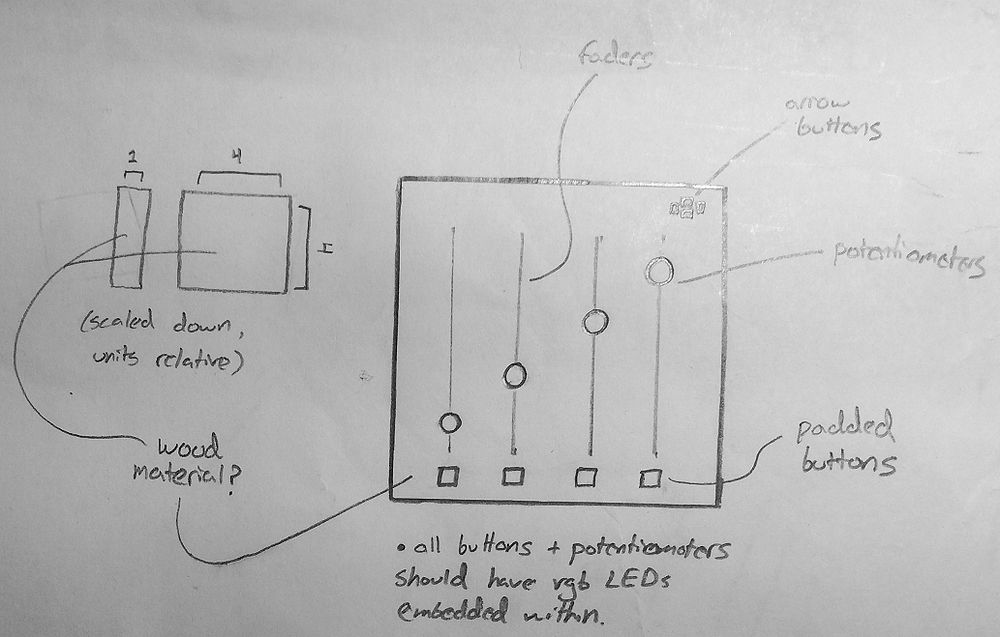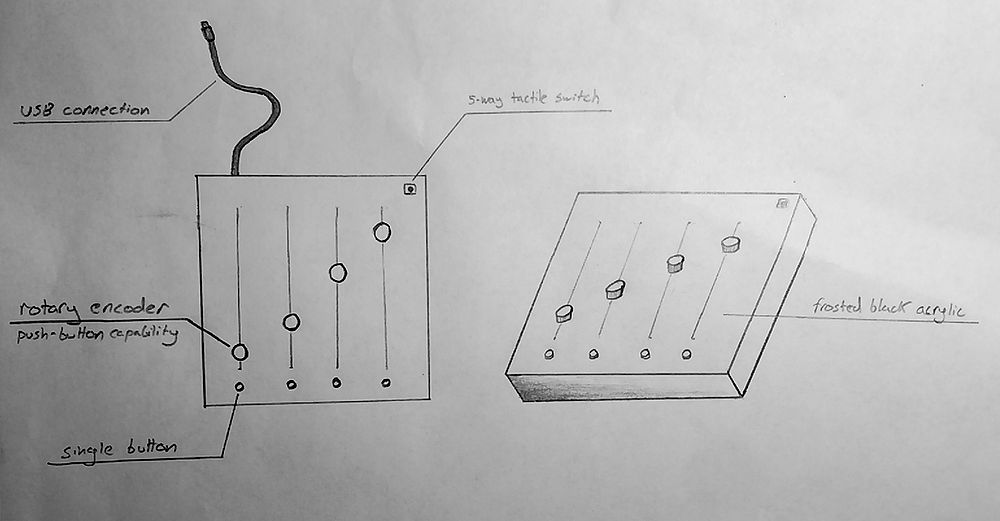Difference between revisions of "User:Gjacuzzi"
| Line 14: | Line 14: | ||
[[File:IMG_0935.jpg|border|1000px]] | [[File:IMG_0935.jpg|border|1000px]] | ||
| − | + | Original off-the-cuff concept sketches for a modular midi controller, note magnetic connections | |
[[File:IMG_0937.jpg|border|1000px]] | [[File:IMG_0937.jpg|border|1000px]] | ||
| − | + | Fine-tuned 3d sketch of the modular midi concept | |
[[File:IMG_0936.jpg|border|1000px]] | [[File:IMG_0936.jpg|border|1000px]] | ||
| − | + | Abandoning modular midi for the sake of time and complexity, focusing on a single component | |
[[File:IMG_0938.jpg|border|1000px]] | [[File:IMG_0938.jpg|border|1000px]] | ||
| − | + | Current concept sketches for multi-functional midi controller | |
== Research + Info == | == Research + Info == | ||
Revision as of 01:41, 3 November 2014
Rough Schedule
11/03 - order parts, finalize design, and create housing template
11/10 - finalize housing template, laser cut housing, begin assembly
11/17 - finalize assembly and begin programming
11/24 - finalize programming
12/1 - solve any remaining issues and take care of fine tunings
12/2 - make and practice presentation
12/3 - final presentation
12/4 - documentation
Sketches
Original off-the-cuff concept sketches for a modular midi controller, note magnetic connections
Fine-tuned 3d sketch of the modular midi concept
Abandoning modular midi for the sake of time and complexity, focusing on a single component
Current concept sketches for multi-functional midi controller
Research + Info
Examples of other work
- Victory Siren on the White Holly by Dan Das Mann (Sausalito Lighted Boat Parade): http://oaklandvictorysiren.com/movies/victory_siren_on_the_white_holly.php#more
- Musical Siren by Bart Hopkin: http://windworld.com/features/gallery/musical-siren-built-by-bart-hopkin/
- Siren Organ by some kid: http://www.youtube.com/watch?v=rAHGhRABI9g (skip to the last 10 seconds): air generated by him, not very loud
- THIS: Siren Organ based on 1915 Loman patent: http://www.youtube.com/watch?v=gSn4EUNXz4M
- Same person as above: The Helmholtz doppelsiren (double siren? for beating paterns): http://www.renebakker.com/2012/works/helmholtz-doppelsiren/
(* what the hell NAMTA? http://www.namtamusic.com/siren-wi-organ-lessons)
- Vertiges, a pretty serious piece composed for "siren organ": https://vimeo.com/61600835 - not exactly clear how this instrument is a siren (and perhaps its name is given more for its timbre). appears to be sensors in the horns that detect distance to the hand. very beautiful implementation though. more here: http://www.chicagoreader.com/chicago/jean-francois-laporte/Content?oid=915538 - "built instruments with names like the Tu-Yo and the Siren Organ out of air compressors, pneumatic valves, and boat horns"
- not totally related, but I always find the Swarmatron inspiring in its tone; love the continuous oscillators: http://www.youtube.com/watch?v=uuM4yBFI03E
- a homemade pipe organ. We can make individual air valves like he does http://www.sentex.net/~mwandel/organ/organ.html. How it works: http://www.youtube.com/watch?v=d5baNcgIA8o
MVP. We built a disc with evenly spaced holes attached to a rotating motor and a 9V battery. Blowing on the spinning disc does indeed produce pitch! The motor was rather noisy until we figured out a position to squeeze it (near the top) that makes it virtually silent. Then, we iterated, and attached a potentiometer (fader) to control the voltage. This successfully created a moving pitch that sounded very siren-like!
The Plan. We want to build a "siren organ" with some faders to control rotational speed of the motor(s) (frequency), other faders to control the applied air pressure (volume), and buttons to control solenoid valves to turn the sirens on/off.
Unlimited Time + Resources Vision. It's more about unlimited money than time--I think we can achieve something cool. We're ditching the bike idea, I think.
Elevator Pitch. An "organ of sirens" with the feel of a MIDI instrument. Faders control the volume and frequency of mechanical sirens, while buttons turn them on and off.
Materials Needed
* motors (6, one for each disk)
* MOSFETs (6) http://www.jameco.com/webapp/wcs/stores/servlet/Product_10001_10001_669951_-1
* tubes/air hose (24)
* solenoid valves (24):
* 7psi model (might need more): http://www.jameco.com/webapp/wcs/stores/servlet/Product_10001_10001_169835_-1
* air directional control valves: http://www.mcmaster.com/#air-directional-control-valves/=p6xufn
* arduino (1)
* power source (1?)
http://www.12vadapters.com/adapter/power-supply/12v/10-amp-10a.html
* keys/piano/organ interface (faders + buttons + enclosure)
* disks (12)
* enclosures for the disks (6)
* horns? (6)
* also check out air (pneumatic) controls for air rifles, potato canons, pipe organs, etc. http://www.youtube.com/watch?v=DG6own141z0 shows how to make a homemade check valve with pvc connectors and a bouncy ball.
Next Steps. The next steps are to build a 5-fader, 4-button, 1-motor model, where 4 faders are devoted to air hoses over the individual rings of 1 disk (different pitches) and control the air pressure of each hose, and 1 fader is dedicated to the spin of the motor. The 4 faders could possibly control ball valves to partially open/close the air hoses as opposed to flow, which we do not have a good grasp of how to control (cheaply; a regulator might work). The buttons could also serve as the valve control, or could power on/off the air supply.



